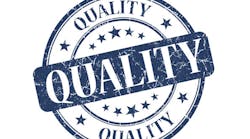Harold Dodge, one of the founders of quality management, changed our view on quality with a vital statement: "You cannot inspect quality into the product." Dr. Deming helped make the quote famous. The only problem with this statement is that it is decades old yet not nearly fully adopted by manufacturing organizations or even their quality functions.
This starts with trying to understand what quality really means. Does it mean within specification? If you truly observe the behaviors and decisions of many companies, this would be their working definition. But this is useless if the specifications don't meet customer expectations, wants or needs. If you're in manufacturing, you might go back to your manufacturing team and say, "Not my problem, I can only build what I'm given." But that won't sell your product, or serve your organization.
1. The Customer. To start building your quality system, you must begin with the end in mind. Specifically, what does the customer truly value? It may not be exactly what they tell you they care about. You need to be able to take their feedback, your observation and good data on their behaviors to understand the customer's true values.
2. The Inputs. On the other end of the system, you must understand the key levers as inputs to a good quality output. Basically, if we do these things right, our results should be just fine. For example, how both materials or parts and information is presented to users is crucial. Is it hard to select the right component? Is it hard to read the build sheet and know what decision to make? Standard work has also been a key component of quality output but is often treated as primarily an efficiency tool. Does the individual follow a standard process (whether it's written or not)? How can you tell? How can they tell?
3. The Feedback. Since quality is dynamic, we cannot just design it out of the system; we have to effectively react to it. Your feedback, and feed-forward, loops must be designed to be visible, relevant and timely. Are you feeding back the right information? Is it getting to the right person or role? And how long does it take to detect the issue, communicate it and react to it? Too often, the feedback isn't getting either to the people inadvertently causing the problem, or to those who can do something to fix it. And if it is, we create multiple quality signals that tell us eight different things in eight different ways. Which one am I supposed to react to? You can't react to the top issue on eight different signal inputs. You must design your feedback systems so that people can see the entire problem landscape and then make good decisions about where to put their resources.
4. The Problem Solving. Perhaps most importantly, you must connect and engage effective problem solving for the issues found. Too many think this means the procedure of whether we do an 8D or an A3 or a Six Sigma project. But more important than the tool or template is the effort taking place. Is there a committed resource to solve quality problems, or is there a committed time allocation for another resource? Do we solve these problems to true resolution or just work it until the next problem surfaces? Are we just fixing the problem or are we fixing the system as we learn?
5. The Quality Department. I wrote many of the key items above as questions rather than just critical success factors, in part because I'm getting ready to assess an organization's quality system, but also because it is the role of the quality department. The role of the quality department shouldn't just be to fix the biggest problems on the list. They should be the chief architects of the quality design, designing and redesigning the feedback loops, understanding the customer's real needs, and being great coaches of problem-solving efforts.



